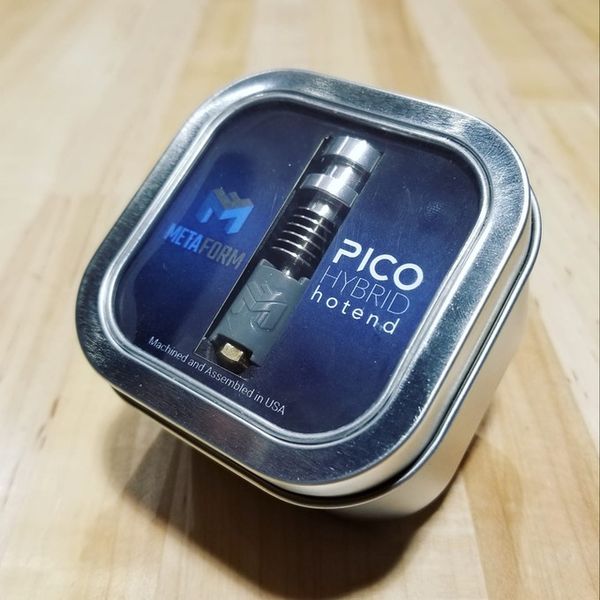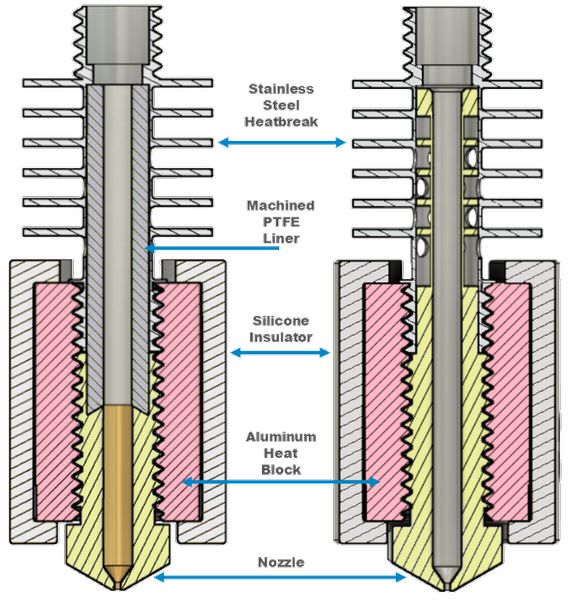
Well, it seems the Pico Hybrid has finally made it!
The Pico Hybrid has an incredibly long story in 3D printing, beginning way back in 2014. At that time the Pico hot end had been a successful crowdfunded product and the company behind it, B3 Innovations, was busy working on a new product, the Pico Hybrid. The proposed hot end would have been smaller and more powerful.
Unfortunately, it never made it. B3 Innovations abruptly performed one of the most incredible business pivots I’ve seen in 3D printing, changing their business from hot ends to sauce holders. I told this tale in a piece from last year with my favorite title: “The Strange Tale Of B3 Innovations Ends In Dipping Sauce”.
While B3 Innovations moved away to sauce-land, the Pico Hybrid was basically abandoned and the company hoped someone else would pick it up. And so that came to pass when it was acquired somehow by Missouri-based Metaform LLC.
This new company attempted to launch the Pico Hybrid earlier this year, but failed to do so. Metaform’s Chief Operating Officer Aaron Kaplan said:
”We have since cancelled that pre-order, refunded those who participated, and relaunched on Kickstarter.”
The Pico Hybrid did indeed launch on Kickstarter last week, and this time they’ve passed the finish line by announcing the project being fully funded in only 48 hours. At time of this writing they have well over 300 orders, so it seems they’ve succeeded.
Pico Hybrid Hot End

What has attracted all those buyers to the Pico Hybrid? Despite its design and concept age, it sports a number of terrific features. Here’s some that caught my eye:
Multi-Diameter Capability
Most hot ends are either 2.85 or 1.75mm in diameter, and you must supply filament to match. However, the Pico Hybrid has a way to switch diameters in “seconds” with a nozzle swap. This is a massive feature for those who have a pile of leftover filament with the “wrong” diameter.
Hot Or Cold Hot End
Typical hot ends are designed to be either all-metal or not. All-metal means they are capable of being heated to 300C or so without melting any plastic parts. That’s important as one of the typical parts in a hot end is the PTFE tube, which, when heated too high, emits noxious chemicals. A non-all-metal hot end is “slippery” and is able to handle flexible or low-temperature materials.
The Pico Hybrid has a way to change this capability as well simply by swapping the nozzle. It seems the “nozzle” design is more than just the tip, but includes other features inside the hot end.
Pico Hybrid Hot End Weight
The Pico Hybrid hot end is also very lightweight at only 28g for all components — that includes the heater, thermistor, fan and mount.
A lightweight hot end is very important for higher-speed 3D printing as the 3D printer’s motion system does not have to counteract a large momentum when changing directions. In other words, there is the possibility of 3D printing faster when a lighter-weight hot end is used, particularly with Bowden configurations.
Reinforced Wiring
The Pico Hybrid also includes metal-reinforced wiring, and this is quite important. Many hot end failures occur when globs of plastic are mistakenly extruded around the hot end during a print failure. When removing these blobs there is the possibility of ripping off the wiring, and when that happens you have even more to fix. This is less likely with the Pico Hybrid as the wires are stronger.
Pico Hybrid Materials
The system includes three types of nozzles: PTFE-lined Brass for most common 3D print materials, including flexibles; a PTFE-lined “Hardened” version for low-temperature materials containing abrasive materials; and finally an all-metal hardened version that can handle higher-temperature materials such as PEEK or ULTEM.
The flexibility of this system means that with a single 3D printer and these three nozzles, one could enable successful 3D printing of practically all possible 3D print materials. Of course, there’s no guarantee that they will work because successful 3D printing also depends on the rest of the machine — higher-temperature materials require enclosures, for example.
Pico Hybrid Compatibility
Due to its small size, this hot end may not quite fit the same when replacing an existing hot end. However, it seems that Metaform has provided different types of mounting systems to allow widespread use of the Pico Hybrid. For example, there is an extension to fit on the popular E3D-Online V6 mount.
Pico Hybrid Availability
The Pico Hybrid is available for order now on Kickstarter for a couple of weeks yet. Its normal price is US$149, but during the launch the price is as low as US$119.
Via Kickstarter
